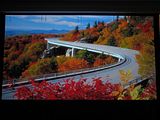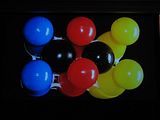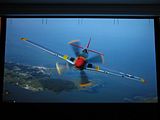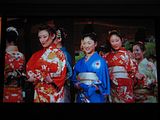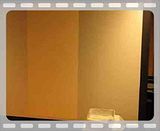Portable & Lightweight Fixed Screen Frames
Author: EM3
Since the beginning of time (ok projectors) man has struggled for a cheap easy lightweight solution for a screen.
The PVC Solution.
PVC pipe has been used to create a screen frame and here is how it is done. PVC elbows for the 4 corners and 4 tees two top and tow bottom for a 16:9 screen. This will strengthen the long side of the screen and make parts shorter to fit in your car. In order to attach the screen the fabric store sells grommets that come in 2 pieces and you place them on each side of the material and with a special punch tool (comes with them) you smack it with a hammer and they attach. Just like the eyelets in a tarp. I have had best luck with these when I doubled over thin material. With Black Out Cloth you may or may not have to double. Place these eyelets/ grommets about every foot around your fabric and then use bungee cords from top to bottom side to side to hold tension, or lace it up with some cords.
Tools required scissors, hacksaw, and hammer
Aluminum frames have also been used to some extent and here are some thoughts on that.
1 1/2 inch square aluminum tubing can be found at Home Depot. They have it in the hardware section. It was easy to cut with a hack saw in a regular miter box. It comes in eight foot lengths which worked out fine for a 100 inch screen.
The great thing about the aluminum is that it's very light and very straight. I had been looking through the lumber and it all weighed a lot and it was hard to find a piece long enough that wasn't warped.
Also at Home Depot I found a framing clamp for putting corners together. You put the two pieces together and screw it tight. I used this to hold the corners square while I drilled the holes for the brackets. I put 3 inch corner brackets on the back at each corner.
In the spray paint section I found textured black paint. This came out looking just like a powdered aluminum finish.
At the fabric store I got some budget blackout cloth, and a lot of black velcro. I put velcro around the whole edge of the cloth and the back side of the frame. To do this easily you can lay the frame on the cloth and use a sharpie marker to draw around the inside. You won't see the line by the time you stretch the cloth a bit. Then just put the cloth on and go around a few times stretching it out. The velcro is strong enough to stretch it flat.
I had some extra velcro so I put another strip of it all the way around the sides of the picture to cut down on reflection.
I put two brass hooks on the top and hung them on brass screws in the wall. The screen is so light that I didn't even bother looking for wall studs. It came out looking totally professional.
I used black, stick-on Velcro.
Here are some tips:
1) The cutting of the tubes.
I used my hacksaw in the miter box - which limited my range of motion - instead of a box saw. I also didn't clamp the tubes down tightly as I was using a cheap Stanley folding workbench that came with table clamps. The offshoot of this was that although the miter cut came out pretty well, they were subtly uneven. This caused alignment headaches later in the angle clamp/L-brace hole marking step.
Recommendation - Use an electric saw (or better, a miter saw ) and clamp securely, or get a machine shop to pre-cut your tubes.
2) Marking the holes to drill.
Rather than trying to mark the screw holes on the tube, I should have just drilled starter holes while I had the tubes and the L-brace secured in the corner clamp. The L-braces are a little bit wider than the tubes, so I had to
use little thick pieces of paper to even up the clamp. Also, be careful to favor the inside frame edge even-ness on the L-clamp rather than the outer - otherwise you'll end up with little edges of the brace peaking out into where the screen will be showing.
3) Attaching the L-braces.
Attach the screws while you have everything secure in the corner clamp. I'm not sold on the self tapping screws for the aforementioned reason. Get a variable speed screw gun, a drill screw bit (or good first aid kit.)
!Alert! Before you attach the final L-brace shake out the little aluminum shards from your handiwork at the other corners or it will rattle.
4) Velcro.
I got the 2" wide industrial strength black. Since my frame
is only an inch thick, I cut the velcro lengthwise to get double the material. You can do this pretty easily by folding sections in half,securing the end with a wide potato chip clip and cutting it down the fold. Btw, it says right on the box that the velcro is not recommended for material. It also recommends that you wait 24 hours for the adhesive to cure before straining it.
Painting the frame:
The Rust-oleum black textured paint recommended did work really well - no drips, etc. I would recommend that you have bright lighting wherever you do the actual painting because it was easy to miss several under painted areas that showed up later.
Hooks for hanging
Make sure you drill smaller starter holes in the top of the frame
Slowly hand screw the hooks into the frame. I felt more
secure going into the wall studs despite the light weight
of the frame (I have needed to take the screen on
and off the wall many times.) I also went with 2 1/2 inch
brass wood screws which seemed to extend out of the
wall a good length for the hooks (although the phillips
heads barely withstood the screwing and stripped
out at the very end. (I didn't pre-drill through the studs.
Floating Aluminum Frame
I used the 1" aluminium tubing from Home Depot with a few modifications.
I'm "floating" the screen a few inches away from the wall and don't bother with black masking. Therefore, I've wrapped the blackout cloth around the outside of the frame.
Two 4'x1" square aluminum tubes
Two 8'x1" square aluminum tubes
(Or three 8'x1" square tubes)
Just over 8' blackout cloth
4 right-angle brackets
Large Binder Clips
The outer height is 50" (4' + top and bottom 1" sections) Therefore the width needs to be just under 89", so cut about 7.11" off the 8' top/bottom rails. No need for a mitre cut!
By wrapping the screen around the tubes, the corners will not spread; the fabric tension keeps it together. Use simple angle brackets screwed into the back and squared with a framing square. Sand the front corners down so the aluminum will not cut the fabric.
Rather than use velcro, I wanted something that would allow me to restretch the fabric, or replace it. I came up with a very simple solution. (It can be hidden with additional fabric, but I haven't bothered.)
Staples has LARGE binding spring clips that can just stretch over the 1" tubing and fabric. After screwing the frame together, lay the frame over the fabric, with the angle brackets up, and clip the
fabric to the frame using the same "diamond" pattern that people use when stapling to wood frames. (Start in the center of each side.)
I let screen pull in slightly at the top and bottom to create tension. Purists may want to install a third vertical bar in the center of the screen.
After all the clips are in position, the handles for the clips can be removed. With the clips in the back, the front surface is a beautiful, smooth, lightweight, tight screen.
For a removable Mask some have tried this method.
Rip down some 1/8 in masonite into 1 or 2 in strips.
Spray them with 3 M glue. Take a wide piece of felt and wrap one end over the strips. Place velcro on the screen frame (over the top of your screen) so that you can adjust the width of the mask. Place velcro on the back of the frame to secure the excess felt.
Stretch Bar Method at this time there is very little discussion going on about this.
I may have found a nice alternative to a custom made frame. They are heavy duty "stretch bars" used by artists to stretch canvass. It should be perfect for a DIY screen. The edge is wood, allowing for stapling, and the other side is aluminum for strength. I will be making a 120" diagonal screen and have already ordered the bars. The cost goes up due to shipping charges for the oversized items, $80 in my case.
I ordered mine from
http://www.utrechtart.com/Canvas/Str...s_Accessories/ and you can see a sample here:
http://www.utrechtart.com/dsp_view_p...item=35488&v=1
Food for thought.
1. Snaps are labor intensive but a feasible method to fix cloth to the frame
2. Screws with washers (or maybe rectangular brackets with two screws) provide a cheap and easy way to fix fabric to the frame.
3. A center brace and strong corner brackets are a must
4. Brushed aluminum does not hinder the viewing experience in a concerning way - I don't think these frames need to be painted.
ACKNOWLEDGEMENTS
Special thanks are given to the originators and contributors of these threads
http://www.avsforum.com/avs-vb/showthread.php?t=700398 Thank you HanktheTankND, RTROSE, and bud16415. Thanks got out to all of those that contributed to this thread
http://www.avsforum.com/avs-vb/showthread.php?t=366191 Thank you Graver, MikeSRC, rdwalt,RONM, Rob Ricket, jonnyb, BreakStuff, myhdgig, Mit07, SR7, trpltongue, mhernie, JeffHT, dd2, ukchris, djordan, Rudy81, mbroder, razorfish. KCK7, stansell, SpeedyG, rrolsbe, aftp302, zambelli, bzb, DavidVTHokie, Mbosco, newpj, sadd3j, ghengis, daurang, timesnewroman, BHendershot, nowknown, Cary_R, PhilM, yeller, sparnold, pjgirl, ambient, quake, feds27, colofan, garyfritz, sfj, Robert Clark, newfmp3, sfj, triodeuser, retroeric, smithmal, DarrinH, DarthGak, tomes, chr1sk, ScreenRider, HuskerHarley, 1 Time, fs123, vultures knob, Vashon Donique, citizen arcane, BlackCatt, (Godlightsoul), JamesE, awesomebase, metropole, jicbulk, Rizman!, uognarf, Smegger, PatrickGSR94, Highside, ellisr63, doublestar, tiddler and stevesemailbox.





